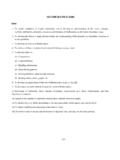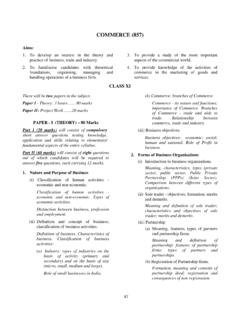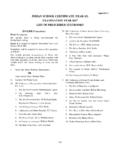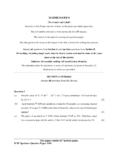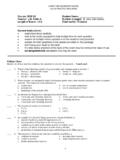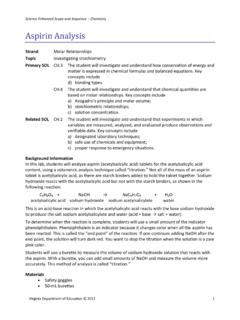Transcription of CHEMISTRY (8 62) - cisce.org
1 167 CHEMISTRY (862) foster acquisition of knowledge and understanding of terms, concepts, facts, processes, techniques andprinciples relating to the subject of develop the ability to apply the knowledge of contents and principles of CHEMISTRY in new or develop skills in proper handling of apparatus and develop an ability to appreciate achievements in the field of CHEMISTRY and its role in nature and develop an interest in activitiesinvolving usageof the knowledge of develop a scientific attitude through the study of Physical acquaint students with the emerging frontiers and interdisciplinary aspects of the develop skills relevant to the apprise students with interface of CHEMISTRY with other disciplines of Science, such as, Physics, Biology,Geology, Engineering, XIThere will be two papers in the I:Theory-3 70 marksPaper II:Practical-3 hours ..15marksProjectWork ..10marksPractical File.
2 5marksPAPER 1-THEORY: 70 MarksThere will be no overall choice in the paper. Candidates will be required to answerallquestions. Internalchoice will be availablein two questions of 2 marks each, two questions of 3 marks each and all the threequestions of 5 marks Basic Concepts ofChemistryPhysical Chemistry32 of Elements and Periodicity Bonding and of Matter: Gases Chemistry15 CHEMISTRY : Some basic Principles andTechniquesOrganic Chemistry23 Marks168 PAPER I THEORY 70 Basic Concepts of ChemistryGeneral introduction: Importance and scope ofmatter. 'satomictheory:conceptofelements,atoms (atomic)and molecular masses, moleconcept and molar mass, percentagecomposition,empiricalandmolecu larformula. Stoichiometryandcalculationsbasedonchemi cal reactions.(i)Precision andaccuracy:Quantities and their measurements inChemistry,significant figures, SIunits.
3 (ii)Dimensionalanalysis:Conversion of units,numericals andapplications of units.(iii)The concept of atoms having fixed propertiesin explaining the laws of about atoms. Dalton s atomic theory:Main postulates of the theory; its of chemical combinations: Law of conservation of mass. Law of definite proportions. Law of multiple proportions. Law of reciprocal proportions. GayLussac s law of gaseous , explanation and simple problemsbased on these laws.(iv)Atomic(isotopic masses) molecular mass and mole:The atomic mass unit is one of theexperimentally determined unit. It is equal to1/12 of the mass of the carbon 12 problems based onmole concept,Avogadro s number andgrammolecularvolume.(v)Empiricalandmo lecularformula:Numericals based on the above.(vi)Chemical equivalents, volumetric calculationsin terms of normality. C = should betaken as a standard for expressing weight expressingthe combiningcapacity of the elements with the standardelements such as H, Cl, O, Ag, equivalent weight.
4 Gram equivalentweights, relationship between gramequivalent weight, gram of equivalent weight of acids,alkalis, salts, oxidising and reducing agents.(experimental details not required).Terms used in volumetric calculations suchas percentage (w/w and w/v), normality,molarity, molality, mole fraction, etc. shouldbe discussed. Students are requiredto knowthe formulaeandnormality and calculations on the above topics.(vii)Chemicalreactions stoichiometriccalculations based on mass-mass,mass-volume,volume-volume relationshipsand limiting ofAtomDiscoveryoffundamental particleselectron,protonandneutron),atom icnumber, 'smodel and itslimitations. Rutherford'sexperimentalmodeland its limitations. Dual nature of matter 'satomicmodel and itslimitations(de Broglie'sequation,Heisenberg suncertaintyprinciple),concept of shells,subshells, ,shapesofs,panddorbitals. Rulesforfillingelectronsinorbitals-aufba uprinciple,Pauli'sexclusionprincipleandH und'sruleof maximum ,stabilityofhalf-filledandcompletelyfill edorbitals.
5 (i)Subatomicparticles (electrons, protons andneutrons)their charges and masses:Conceptof indivisibilityof atom as proposed byDalton does not exist. The atom consists ofsubatomic fundamental particles. Productionof cathode rays and their ofanode rays and s experiment for the discovery ofneutron and properties of (ii)Rutherford s nuclear model based on thescattering experiment:Rutherford sscattering of s nuclear model of atom. Defectsof Rutherford and itslimitations (Black bodyradiation and photoelectric effect)Planck s quantum based on the above.(iii)Types ofspectra:emission and line spectra to bediscussed.(iv)Bohr s atomic of Bohr s theory based onPlanck s quantum of Bohr s atomic model andexplanation ofhydrogen based on Rydberg s on Bohr s atomic radii, velocityand energy of orbits (derivation notrequired).
6 Defectsin Bohr s Model.(v)Quantummechanical modelof anatom-asimple mathematical treatment. Quantumnumbers; shape, size and orientation of s,pand dorbitals only(no derivation).aufbauprinciple, Pauli s exclusion principle,Hund s rule of maximum configuration of elements in termsof s, p, d, f subshells. de Broglie s equation. Numericals. Heisenberg SchrodingerWaveEquation physicalsignificance of and 2. Quantum numbers types of quantumnumbers,shape, size and orientation ofthe s, p and d subshells. Informationobtained in terms of distance of electronfrom the nucleus, node,nodal planesandradial probability curve, energy ofelectron, number of electrons present inan orbit andan orbital. aufbau principle, (n+l) rule. Pauli s exclusion principle. Hund s rule of maximum multiplicity. Electronic configuration of elementsandionsin terms of s, p, d, f subshellsandstability of half-filled and completelyfilled of Elements and Periodicity inPropertiesSignificance of classification;study ofMendeleev s periodic law and its limitations;ModernPeriodicLawandtheprese ntformofperiodictableleading toperiodictrendsinpropertiesofelements-a tomicradii, ionic radii,valency,ionisation enthalpy, electron gainenthalpy, (i)Modern Periodic LawMendeleev s periodic law, defects in theMendeleev s periodic table.
7 Advantages anddisadvantages. Modern periodic law (atomicnumber taken as the basis of classification ofthe elements).(ii)Longform ofPeriodic characteristics of groups of periodic table as s, p, dand f nomenclature forelements with Z> 100.(iii)Periodictrends inproperties radius, ionic radius,ionisationenthalpy, electron gain enthalpy,electronegativity, metallic and non-metalliccharacteristics. Periodic properties such as valenceelectrons, atomic and ionic radii and theirvariation in groups and periods. The idea of ionisation enthalpy, electrongain enthalpy and electronegativity mustbe given and their variation in groups andperiods may be discussed. The factors(atomic number, screeningeffect and shielding effect, the number ofelectrons in the outermost orbit) whichaffect these periodic properties and theirvariation in groups and periods.
8 (iv)Periodictrends inchemicalproperties periodicity of valence or oxidation properties of second relationship; acidic and basic natureof :Recommendations of the latest IUPACfor numbering of groups to be 1 18 replacing old notation ofI given at the end of Bonding and MolecularstructureValence electrons, ionicbondcharacter, covalentbondof ionic bond,covalent bond,bondparameters, lewis structure, polarcharacterofcovalent bond,VSEPR theory, geometryofcovalentm o l e c u l e s,valence bond theory,conceptofhybridisation involving s, p and bond. Molecularorbitaltheoryofhomonucleardiato micmolecules (qualitativeidea only). Resonanceandhydrogenbond.(i)Kossel-Lewis approach rule, itsapplication to electrovalent andcovalent bonds.(ii)Electrovalentor ionicbond:Lewis structuresofNaCl, Li2O, MgO, CaO, MgF2,and of ionic conditions necessary for the formation ofionic bonds such as:-low ionisation enthalpy of electron gain enthalpy of lattice difference between thereacting these points must be discussed in formation of cations and anionsofelementsand their positions in the electrovalency; reasons for variableelectrovalency , due to inert electron paireffectand unstable core, by using of lattice enthalpy (Born-Habercycle).
9 Characteristics of electrovalent bond.(iii)Covalent Bond Bond parameters, Lewisstructure, polar character of covalent bond, and pi bonds formation ofammonia, nitrogen, ethene, ethyne, andcarbon of covalent bond, conditions forformation of covalent bonds, types of covalentbonds, single, double and triple and pi bonds:H2, O2, of covalent bonds based onelectronegativity of atoms-polar and non-polar covalent bond, dipole of CH4,NH3,H2O, ethane, ethene,ethyne and CO2, etc. and their electron dotstructure or Lewis of covalent in electrovalency and forvariable covalency 3 & 5 and sulphur 2, 4, 6 &chlorine 1, 3, 5 and chargeof ions.(iv)Deviation fromoctet rule and Fajan s ofoctet ofoctet rule, due to either incompleteoctet or exceeding ofoctet with s rules:statements,conditions forelectrovalency and covalency.
10 Polar and nonpolar bonds should be correlated withFajan s rules.(v)Valence Shell Electron Pair Repulsion(VSEPR) Theory; Hybridisation and shapesof molecules: hybridisation involving s, p andd orbitals of electron-pair repulsion andshapes of molecules using suitable and molecular shapes definition, hybridisation of orbitals involvings, p and d orbitals (using suitable examples).(vi)Molecular orbital theory: Qualitativetreatment of homonuclear diatomicmolecules of first two periods (hydrogen toneon), Energy level diagrams, bonding andantibonding molecular orbitals, bond order,paramagnetism of O2molecule. Relativestabilities of O2,O2-, O22-, O2+andN2, N2+,N2-, (vii)Co-ordinate or dative covalent bond, of oxy-acids of chlorine:Co-ordinate or dative covalent bonding:definition, formation of chlorous acid,chloric acid, perchloric acid, ammonium ion,hydronium ion, nitric acid, ozone.



